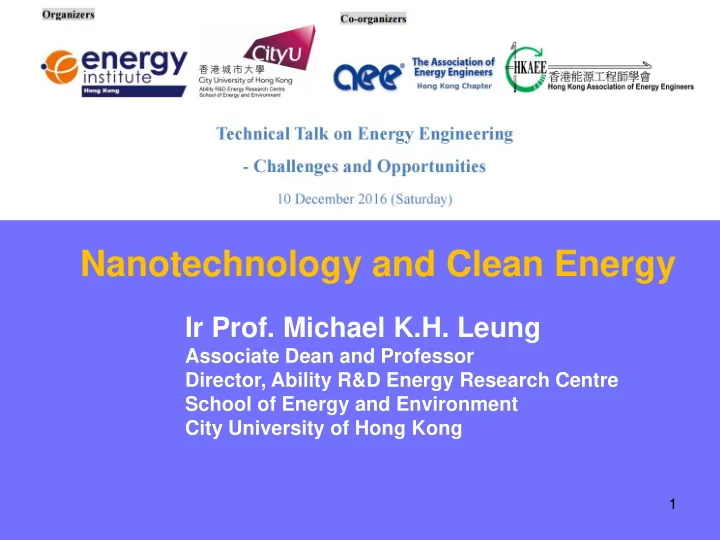

Nanotechnology and Clean Energy Ir Prof. Michael K.H. Leung Associate Dean and Professor Director, Ability R&D Energy Research Centre School of Energy and Environment City University of Hong Kong 1 1
Outline 1. Nanotechnology 2. Nanostructured Photocatalyst 3. Photocatalytic Fuel Cell 4. Other Applications 5. Conclusion 2
Nanoscale • Nanometer (nm) – 10 -9 m • Human hair – 10,000 nm • Atoms – 0.1 – 0.5 nm 6 nm 6 nm 100nm 100 nm 100 nm 3
Properties of Porous Material • Large specific surface area • Increase surface phenomena => higher reactivity • Increase adsorptivity • Facilitate light reflection => better utilization of light in photoactivation • Facilitate electron transport 4
Photocatalysis TiO 2 + h ν → e - cb + h + vb vb + H 2 O → OH · + H + h + vb + OH - → OH · h + cb + O 2 → · O 2 e - - vb - valence band cb - conduction band h + vb - hole OH · - hydroxyl radical Titanium dioxide (TiO 2 ) + UV light 5
Solar Photocatalytic Water Purification Photocatalyst: P25 TiO 2 powder Recovery method: Sedimentation Light source: Solar light
Photocatalytic Air Purification Patent: Light-transmitting tubular-honeycomb photocatalytic reactor , Inventors: M.K.H. Leung, Y.C. Leung, W.C. Yam, P.S.P. Ng, L.L.P. Kwan, Hong Kong short-term patent, publication no.: 7 1099477, publication date: 10 Aug 2007.
Solar Photocatalytic Water Splitting Hydrogen Production 350 (b) TiO 2 -NP-1-1.0Pt 300 TiO 2 -NS-2-1.0Pt TiO 2 -NS-3-1.0Pt 250 TiO 2 -NS-4-1.0Pt H 2 production ( µ mol) 200 150 Ref.: 100 50 0 0.0 0.5 1.0 1.5 2.0 2.5 3.0 3.5 4.0 Irradiation time (hours)
Material Fabrication by Anodization Anodization DC + - 400 nm ~6.4 μ m Ti Pt F - containing EG solution Anode: Cathode: 0.2 μ m 2 μ m 2e - + 2H + → H 2 Ti → Ti 4+ + 4e - Ti 4+ + 2H 2 O → TiO 2 + 4H + XRD Intensity (a.u.) Etching Process: TiO 2 + 4H + + 6F - → [TiF 6 ] 2- + 2H 2 O 2 θ (degree) 9
Fabrication by Hydrothermal Process Temp. & Time Control 10
Various Nanostructures Nanorod Array Nanotube Array Nanosheet Nano-flower Hollow Sphere 6 nm 6 nm 100 nm 100 nm 11
Modification of Nanomaterials CdS/TiO 2 nanorod Ag-Ag 2 S/TiO 2 nanotube Bi 2 O 3 /TiO 2 nanobelt Ref.: W. Fan, S. Jewell, Y. She and M. K. H. Leung, Physical Chemistry Chemical Physics, 2014, 16, 676-680. 12
Fuel Cell Fuel cell converts hydrogen into electricity by electrochemical reactions. Water and heat are byproducts. Proton 13
Originally Designed by NASA for Space Applications Features: • Use available hydrogen fuel • Produce drinkable water • Effective hydrogen recycling Ref.: www.nasa.gov 14
For Commercial Applications • Reduce greenhouse gas emissions • Reduce depletion of finite fossil fuels • Hydrogen is clean and, in practice, it can be produced from water, which is abundant. • Promote diverse, domestic, and sustainable energy resources • Increase reliability and efficiency of electricity generation • Hydrogen technologies can be viable with a transition from conventional technologies 15
Capital Cost of Fuel Cell (US$/kW) Ref.: U.S. DOE, 2012 16
Fuel Cell Cars Mercedes-Benz plug- Toyota in hydrogen fuel-cell BMW hydrogen Mirai fuel-cell vehicle GM Opel HydroGen4 Hyundai Tucson Fuel Cell Honda Clarity fuel cell 17
Stationary Electricity Supply 400-kW hydrogen fuel cell plant in Connecticut 200-kW natural gas fuel cell plant in Sydney 2.4-MW biogas fuel cell plant in San Diego Natural gas fuel cell plant in New Jersey 18
Photocatalytic Fuel Cell • Effective wastewater treatment and simultaneous production of electricity • Low-cost fabrication • Environmental-friendly operation Ref.: Bin Wang, Hao Zhang, Xiao-Ying Lu, Jin Xuan, Michael K.H. Leung , Solar photocatalytic fuel cell using CdS–TiO 2 photoanode and air-breathing cathode for wastewater treatment and simultaneous electricity 19 production, Chemical Engineering Journal, Volume 253, 2014, Pages 174-182.
Dye-Sensitized Solar Cell The dye-sensitized solar cell (DSSC) technology, taken as a new generation of photovoltaics, is a flexible, efficient and economical way to directly convert solar energy into electricity. 20
Thermoelectric Generator Recovery of waste heat from: • Boilers • Engines • Geothermal sources 21
Conclusion Nanotechnology offers enormous opportunities to develop new materials that directly and/or indirectly enhance energy efficiency and promote the use of renewable energy. 22
Acknowledgements Funding Sources • GRF • ITF • ECF • SDF • CityU • Ability R&D Energy Research Centre 23
Acknowledgements 24
Thank You Ir Prof. Michael K.H. Leung School of Energy and Environment City University of Hong Kong Email: mkh.leung@cityu.edu.hk tel: (852)3442 4626 Fax: (852)3442 0688 25
Recommend
More recommend